
“We came to mentor. We returned mentored as well.”
-Dr. Solomon Bililign, Scientist-in-Residence
If you are a science leader who believes in contributing to the world and sparking curiosity in young people, the Scientist-in-Residence Program may be for you.
The Scientist-in-Residence Program connects established science leaders from around the world with inquisitive young people in an underserved community in San Diego, California.
Interactions between the Scientist-in-Residence and the community will help to dispel negative scientific stereotypes, create a more science-informed community, and instill a belief that discovery is possible for everyone, no matter your background.
The Scientist-in-Residence is a competitive program open to science leaders from all professional fields interested in mentoring underserved youth.
If you are interested in this volunteer opportunity, please fill out a Volunteer Application, and Joel Barkan, Education Manager, will reach out to you shortly.
“As I got to know the students better, I was humbled by their stories of the challenges they face, and it was inspiring to see their motivation to learn about ocean science, as well as to hear about their aspirations for the future.”
–Jasmin John, climate scientist and Ocean Discovery’s first Living Lab Scientist-in-Residence
Learn More
Program Background
Press
Residency Opportunities
Expectations
Candidate Qualifications
Funding and Accommodations
Alumni
FAQs
Apply Now
Program Background
Young Scientists Need Mentors
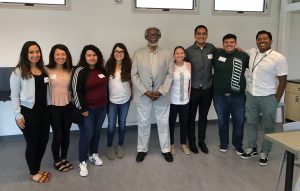
For our students, the small moments with their scientific mentors are the biggest: the conversation about college life over lunch, the impromptu sing-along during the last 10 minutes of a field trip, and the words of praise after a challenging activity.
Story-telling by our science leaders, which includes discussion of their own educational and career pathways, obstacles, as well as their own “spark”, helps to inject a sense of hope into our students – a belief that they, too, can participate in science.
By becoming a Scientist-in-Residence, you will become immersed within a community devoted to nurturing students along their pathway to college and careers. You will share these big and small moments with our students and help them understand that every pathway to a science or science-related career is different.
Giving Back and Making a Difference
Becoming a Scientist-in-Residence can be a transformative experience in the career of any science leader. Through participation, Scientists-in-Residence receive:
- An immersive experience for authentic, meaningful scientific contributions and discoveries that will leave a lasting impact on Ocean Discovery Institute and our students.
- Meaningful time spent directly interfacing with students and the public to communicate personal and/or employer’s research interests.
- Opportunities to meet personal, funder, or employer broader impacts and outreach goals and requirements.
- A mentorship training from experienced Ocean Discovery Institute staff.
- Opportunities to network with other scientists in San Diego’s exceptional scientific community.
Residency Opportunities
Time Period: Year-round except July & August
Duration: 1-2 weeks
Audience: Students of all ages
Setting: State-of-the-art science education facility in an urban neighborhood
Purpose: Mentor students across programs
The residency takes place at Ocean Discovery Institute’s Living Lab facility in San Diego. The Living Lab was intentionally designed to include an attached studio apartment for visiting scientists, because we know scientists from around the world who are committed to mentoring our students. In the heart of our urban community, the Living Lab is the home for our programs, where thousands of students of all ages visit annually.
Picture a Day at the Living Lab
Residency openings
You can check this section to see when future openings are filled by Scientists-in-Residence and which openings are still available.
2025:
- January: n/a
- February: Filled
- March: n/a
- April: Filled
- May: n/a
- June: Filled
- July: n/a
- August: Open August 4-8 only
- September: Open
- October: Open
- November: Open
- December: Open
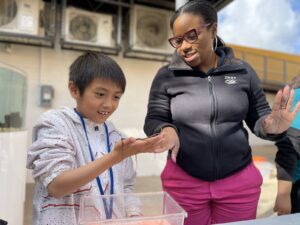
Expectations
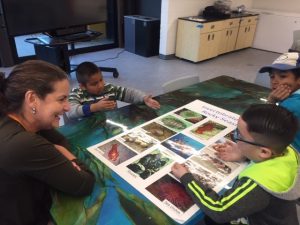
Mentor students across all Ocean Discovery Institute initiatives through integration into existing programs. The following represents your baseline involvement in programs, with opportunities to go more in-depth depending on your interests and the time of year:
- Weekday mornings:
- give career presentations to visiting school classes
- Weekday afternoons:
- give career presentations to students in our after-school camp
- integrate into existing after-school science programs
Deliver presentations to students, staff, and our community about your career and the pathway you took to get there.
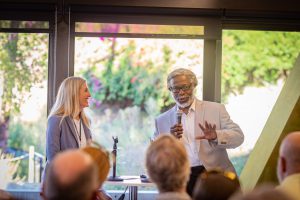
Join in informal gatherings and conversations with students, such as over meals or while working on projects, that—collectively—build trust and relationships between scientists and students and ultimately build a sense of belief that a career in science is possible.
Connect your network of science professional colleagues to the organization to facilitate more science mentorship for our students.
Duration:
Most residencies last for 1 week, but longer stays are welcomed. We have had some Scientists-in-Residence stay for 1 week and some stay for 2 months. Any length of time will yield positive and meaningful interactions with our students.
Workday:
The Scientist-in-Residence is expected to be “on the clock” and available to interface with students or work on projects while the Living Lab is open: Monday-Friday from 8am – 6pm. This does not mean a 10 hour workday, every day – those are simply the hours when the Scientist-in-Residence should be available. Scientists-in-Residence are encouraged to pursue a roughly 50/50 balance of time engaged in Ocean Discovery responsibilities and maintaining critical elements of their “day jobs”.
Policies:
The Scientist-in-Residence must adhere to all Ocean Discovery Institute policies and procedures. During “off-the-clock” time spent interacting in the community and on days off, the Scientist-in-Residence must act as a professional and respectful ambassador of Ocean Discovery Institute.
Accommodations:
In order to become fully immersed in the community, Scientists-in-Residence are expected to live in the Living Lab studio during their terms; however, alternate arrangements can be discussed on a case-by-case basis. Families may come to San Diego, but the Living Lab studio can only house 2 adults (and potentially a small child depending on the parents’ comfort). No pets are permitted in the Living Lab studio. Families can participate in activities and programs with the Scientist-in-Residence that are open to the general public.
Candidate Qualifications
Our definition of “scientist” is intentionally flexible and meant to include any professional who is a science and conservation leader from all science and environmental fields. Potential candidates are professionals who:
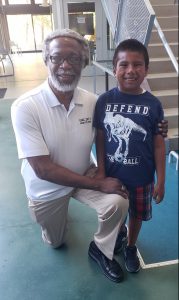
Professional Experience
- Are currently employed (with the exception of retirees) in either a STEM field conducting science research; or, may not actively conduct research, but have a science background and work for a STEM employer; or, work in a STEM position with a non-STEM employer.
- Examples could include:
- A university professor;
- A scientist employed in industry;
- A non-research based position in a STEM agency or industry but with a science background; or
- An employee of a non-STEM agency or industry whose position is STEM-focused (such as a governmental or corporate employee who specializes in scientific topics).
- Are interested in and qualified to complete a unique project that fulfills an Ocean Discovery Institute need.
- Have a strong interest in mentoring students and comfort with informal interactions with diverse groups of people.
- Are at least 25 years old and have a minimum of 5 years of post-undergraduate experience, either in graduate school or employment in a scientific field.
- Examples could include:
Personal Qualities
- Must reflect the racial diversity of our City Heights community. Given that our students come from racial and ethnic backgrounds that have been traditionally excluded from science, it is our priority that students are mentored by scientists from representative backgrounds. This holds true to our organizational values and demonstrates to our students that there are role models in science who represent them. At the same time, we strive to be inclusive of all individuals who want to mentor, and encourage interested candidates who do not meet this criteria to view our other opportunities for engagement.
- Have an interest and ability to communicate science with the general public.
- Are comfortable with living in a community setting.
- Have an interest and ability to integrate into Ocean Discovery’s organizational culture, which prioritizes:
- An unshakable belief in young peoples’ ability to transform their lives;
- Learning, diversity, stewardship, leadership, and passion as the values that shape our actions;
- Our roots in the community which we serve;
- Innovation at the forefront of our work, which is driven by both data and instinct;
- Servant leadership, defined as leadership through serving others and enriching others’ lives; and
- Fun
- Can generate the “spark” that creates an interest in science in young people, either via their research interests or personality.
Other Requirements
- Can pass a fingerprint background check and a TB test.
- Have proof of COVID-19 vaccination.
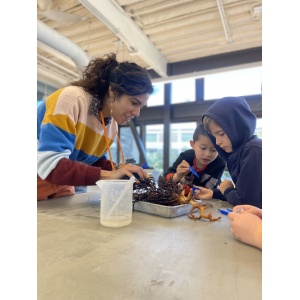
Funding and Accommodations
Ocean Discovery does not provide funds to support the Scientist-in-Residence’s salary. A candidate must have salary funding from his/her employer or through secured grants.
- Ocean Discovery Institute will provide the following at no cost to the Scientist-in-Residence:
- Housing and utilities in the fully-equipped Living Lab studio apartment
- Ground transportation in San Diego if not provided by the Scientist-in-Residence’s employer
- Basic laboratory equipment
- Basic field supplies
- General office supplies
- General educational supplies
- The Scientist-in-Residence, or their employer, is responsible for the following expenses:
- Travel to and from San Diego (although in many cases, Ocean Discovery can provide free airfare thanks to our sponsorship by Southwest Airlines)
- Meals
- Pre-residency expenses such as TB tests and LiveScan background checks
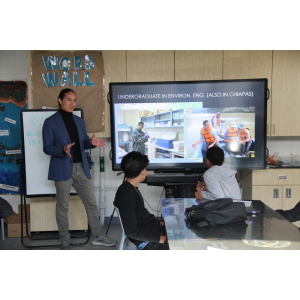
Alumni
Learn about previous scientists who have joined Ocean Discovery on a Living Lab residency.
FAQs
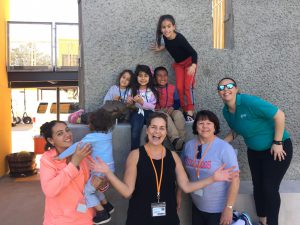
Residency Questions
How long would I be there?
As long as you are able to, for at least 1 week. For many Residents, 1 week is a reasonable length of time to be away from home and become immersed in our community. Other Residents may have the ability through their employer to take an official assignment and pursue a longer residency, up to 2 months.
What if I am not a scientist?
This position is for “science leaders” – defined as individuals working in science and science-related fields who guide and inspire others by influencing knowledge with their thinking and ideas. Their work may involve creating new technologies, or doing scientific research and communicating and teaching that research to others. Science leaders develop structure and frameworks that build knowledge about our world, help solve problems facing our planet, improve human lives, and make our world a better place. Science Leaders can come from a wide variety of science and science-related fields. A science or science-related career, as defined by the National Science Foundation, is any position which is filled by a college graduate in a science or science-related field of study. These fields can range from biologists to computer scientists to engineers to social scientists to postsecondary teachers. More detailed qualifications can be found in our “Candidate Qualifications” section. If you are still interested but not sure if you qualify, you are welcome to contact Joel Barkan at jbarkan@oceandi.org to discuss further.
Do I need to have education/teaching experience?
No prior education experience is required, but comfort and willingness to interact with diverse groups of young people is, as Scientists-in-Residence interact with our students on nearly a daily basis. Ocean Discovery also provides a mentorship training to all Residents at the beginning of their stay.
Do I need to prepare projects or activities to do with students?
No – our program model includes robust sets of existing curriculum, led by our skilled & experienced instructors. The Scientist-in-Residence is “plugged in” to these existing programs with a primary role of providing mentorship to students during their experiences at Ocean Discovery. If any Scientist-in-Residence has a strong desire to develop new student activities, we are also happy to support these and facilitate them either at Ocean Discovery’s Living Lab or at one of our partner schools.
What if I live in San Diego?
San Diego-based scientists are welcome to apply. A part of the commitment does involve staying in the Living Lab’s studio apartment, even if the scientist is local. San Diego-based scientists who prefer not to leave their homes can still be involved in other capacities.
Can I bring my pet?
Sorry, no pets (with the exception of service animals) are permitted inside the facility.
Can I bring my family?
The Living Lab’s studio apartment can accommodate two adults and one child. Family members could have the same access as the general public to the Living Lab and Ocean Discovery programs, which means they could volunteer during certain programs but would have restricted access when not volunteering.
If you wish to bring your family to San Diego during a residency, you are also welcome to arrange off-site lodging for them.
Scientists who are partners may also apply for Scientists-in-Residence positions together and undertake a residency together.
What if I am retired?
We welcome anyone who is retired and meets our basic qualifications to apply for a residency.
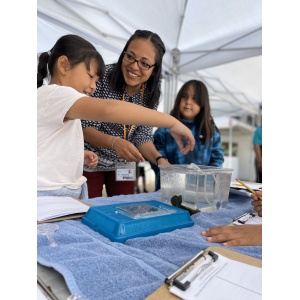
Application Process
The following represents the typical timeline for a single residency:
1. Application
Candidates submit applications for the next open residency position
2. Interviews
Candidates interview for the next open residency position
3. Selection
Be selected for a residency
4. Planning
Plan the logistics and details of your residency through meetings with Ocean Discovery staff
5. Orientation and Training
Receive an orientation and training for your residency
6. Implementation
Provide scientific mentorship during your residency
7. Debrief
Provide feedback on your experience upon completion
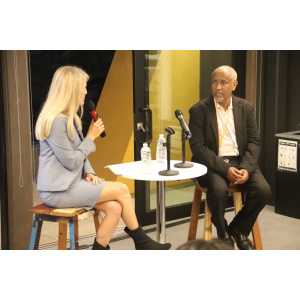
The application process for the Scientist-in-Residence position is competitive. A limited number of residencies are available each year and applications will be closed once all open residencies are filled.
Preference is given to candidates who help the Scientist-in-Residence program achieve a holistic diversity of gender, ethnicity, and different science, conservation, and environmental fields.
Begin Your Scientist-in-Residence Application
If you have questions or would like additional information about the Scientist-in-Residence program, please contact Joel Barkan at JBarkan@oceandi.org.
If you are a confirmed Scientist-in-Residence, access our portal here:
